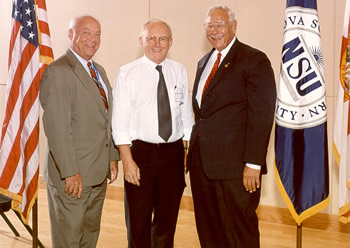Classification of Different Masticatory Activities by EMG Signal Levels in Patient with Different Types of Malocclusion
Grant Winners
- Rodolfo Acosta-Ortiz, D.D.S. – College of Dental Medicine
- Wallace Marsh, Ph.D. – College of Pharmacy
- Keith Sherwood, D.D.S. – College of Dental Medicine
- Malcom Meister, D.D.S. – College of Dental Medicine
- Robert Brandt, D.D.S. – College of Dental Medicine
Deans
- Robert Uchin – College of Dental Medicine
- William Hardigan – College of Pharmacy
Abstract

Differentiation between functional and parafunctional mandibular activities has always been a challenging task; and objective measurement of these activities is of critical importance in the design of studies investigating epidemiological factors and treatment approaches for a variety of disorders of the masticatory system. Our research studies, using Electromyography (EMG), have shown that EMG may allow the identification of these mandibular activities. Overall, the results have suggested that masticatory activities can be predicted with a high level of accuracy based upon the EMG amplitude signal level of the activities, which may facilitate the identification of mandibular masticatory activities in patients with a full compliment of teeth. Although, EMG has been used to quantify muscle activity in different types of malocclusion and during orthodontic treatment, prediction of masticatory activities by EMG signal levels in patients with different types of malocclusion have not been performed. Our main objective is to use EMG signals produced by normal masticatory activities to classify jaw masticatory activities in patients with different type of malocclusion. In addition, the changes that orthodontic treatment will have in the classification of muscle activities will also be analyzed. The sample will consist of ninety patients whose orthodontic treatment has been planned. Six separate recording sessions were performed for each subject. (Three sessions before and three sessions after the orthodontic treatments are started). During each session the subjects will be asked to perform different voluntary mandibular tasks. EMG activity for each task will be recorded for the anterior temporalis (Ta) and masseter muscles (Mm) bilaterally. The potential benefit of this study is if we can develop an EMG method to easily identify different mandibular activities, treatment outcomes for the masticatory system will better be evaluated.